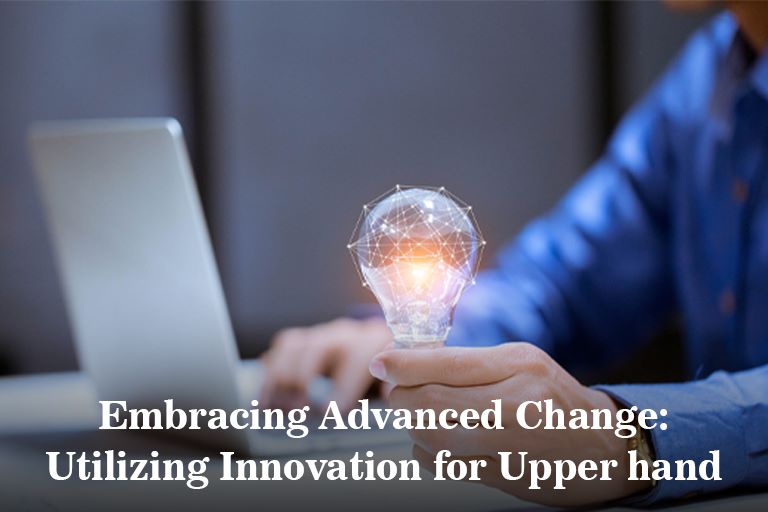
Embracing Advanced Change: Utilizing Innovation for Upper hand
In the present quickly advancing business scene, embracing computerized change has become basic for associations looking to remain in front of the opposition. The intermingling of innovation and business has opened up vast opportunities for organizations to smooth out tasks, improve client encounters, and gain a critical upper hand. By outfitting the force of innovation, associations can streamline processes, drive advancement, and adjust to steadily changing business sector elements. In this article, we investigate how organizations can embrace computerized change to use innovation for a practical upper hand.
- Understanding Advanced Change:
Computerized change involves the mix of computerized innovations into all parts of a business, in a general sense significantly impacting how it works and conveys worth to clients. It includes utilizing arising innovations, for example, man-made reasoning, distributed computing, information investigation, web of things (IoT), and robotization to upset business processes, improve direction, and make new plans of action.
- Enhancing Functional Effectiveness:
One of the essential advantages of advanced change is the capacity to upgrade functional proficiency. Via mechanizing dreary undertakings and utilizing information-driven bits of knowledge, organizations can smooth out processes, lessen costs, and further develop efficiency. For example, carrying out mechanical cycle robotization (RPA) can dispense with manual information section, limiting blunders and speeding up work processes. Besides, distributed computing empowers adaptable foundation and adaptable asset designation, permitting associations to scale procedures on request.
- Personalizing Client Encounters:
Advanced change engages organizations to convey customized and consistent encounters to clients, accordingly fortifying brand steadfastness and consumer loyalty. By utilizing information investigation and client relationships in the executive’s (CRM) frameworks, associations can acquire profound experiences in client inclinations and ways of behaving. This information empowers designated showcasing efforts, customized item suggestions, and custom-made client assistance, bringing about improved client commitment and maintenance.
- Driving Advancement and Readiness:
Innovation-driven change powers advancement by empowering associations to quickly create and convey new items, administrations, and plans of action. Embracing dexterous strategies and cultivating a culture of development energizes trial and error and persistent improvement. For instance, organizations can use man-made consciousness and AI calculations to dissect immense measures of information, uncover designs, and recognize new market open doors. By embracing advanced change, organizations can remain coordinated and adjust quickly to changing business sector elements, guaranteeing they stay at the bleeding edge of their enterprises.
- Harnessing Information for Experiences and Navigation:
Information has arisen as an important resource in the computerized age. By utilizing progressed investigation instruments and strategies, associations can separate noteworthy experiences from tremendous datasets. These bits of knowledge empower information-driven navigation, assisting organizations with recognizing patterns, expecting client needs, advancing tasks, and driving vital drives. Additionally, utilizing prescient investigation permits organizations to make exact conjectures, relieve gambles, and benefit from arising open doors.
- Collaborating and Associating in the Advanced Period:
The advanced change improves interior cycles as well as works with joint effort and availability across environments. Cloud-based joint effort devices, project the board
stages, and
venture informal organizations empower consistent correspondence and information division between workers, groups, and accomplices. This network cultivates development, empowers remote work, and upgrades coordinated efforts on a worldwide scale.
- Embracing Online Business and Omnichannel Encounters:
Advanced change has reformed how organizations draw in clients through online business stages and omnichannel encounters. By laying out major areas of strength for a presence and giving a consistent client venture across different touchpoints (counting sites, versatile applications, web-based entertainment, and actual stores), associations can take care of the developing necessities and inclinations of their clients. This grows their client base as well as considers customized advertising, designated advancements, and proficient stock administration.
- Emphasizing Network Safety and Information Protection:
With the rising dependence on advanced innovations, associations should focus on network protection and information security. As organizations gather, store, and dissect a lot of client information, the gamble of digital dangers and information breaks turns out to be more critical. Advanced change requires strong safety efforts, including encryption, multifaceted validation, customary security reviews, and representative mindfulness preparation. By guaranteeing the security and protection of client information, associations can construct trust and separate themselves from contenders.
- Capitalizing on Man-made consciousness and AI:
Man-made consciousness (simulated intelligence) and AI (ML) innovations are at the front of computerized change. Computer-based intelligence-controlled chatbots, remote helpers, and wise robotization frameworks can smooth out client support processes, handle routine requests, and further develop reaction times. ML calculations can dissect huge datasets to recognize designs, anticipate results, and improve activities. Associations that successfully influence simulated intelligence and ML gain a critical upper hand via robotizing undertakings, improving direction, and conveying customized encounters.
- Fostering a Culture of Constant Learning and Versatility:
Computerized change isn’t just about embracing new advances; it requires a change in outlook and culture inside associations. Organizations should cultivate a culture of nonstop learning, versatility, and development to flourish in the computerized time. Empowering representatives to upskill and reskill in arising advancements, advancing cross-utilitarian joint effort, and embracing deft techniques are fundamental components of this social shift. By enabling workers to embrace change and remain in front of industry patterns, associations can keep up with their strategic advantage.
- Leveraging Information Investigation for Prescient Bits of Knowledge:
As well as utilizing information for independent direction, associations can tackle the force of cutting-edge investigation to acquire prescient bits of knowledge. Prescient investigation models can expect client conduct, market patterns, and request designs, empowering organizations to proactively adjust their techniques. By recognizing likely open doors and dangers, associations can go with informed choices, advance their item contributions, and foster proactive promoting and deals crusades.
Conclusion:
Embracing computerized change and utilizing innovation for the upper hand is as of now not a choice but a need for organizations. By upgrading functional effectiveness, customizing client encounters, driving development, bridling information, and cultivating a culture of flexibility, associations can situate themselves for progress in the computerized period. Organizations must embrace computerized change as an essential objective, adjust it to their business objectives, and reliably put resources into innovation, ability, and foundation. Thusly, associations can remain in front of the opposition as well as make supportable development and worth in the present quickly changing business scene.
Read more – The Ascent of Electric Vehicle Charging Foundation: Difficulties and Arrangements
Read more – The Reception of Biometric Innovation in Vehicles: Improving Security and Accommodation



